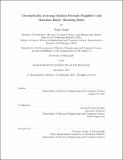| dc.contributor.advisor | Armando Solar-Lezama. | en_US |
| dc.contributor.author | Singh, Rohit, Ph. D. Massachusetts Institute of Technology | en_US |
| dc.contributor.other | Massachusetts Institute of Technology. Department of Electrical Engineering and Computer Science. | en_US |
| dc.date.accessioned | 2018-03-02T21:40:03Z | |
| dc.date.available | 2018-03-02T21:40:03Z | |
| dc.date.copyright | 2017 | en_US |
| dc.date.issued | 2017 | en_US |
| dc.identifier.uri | http://hdl.handle.net/1721.1/113938 | |
| dc.description | Thesis: Ph. D., Massachusetts Institute of Technology, Department of Electrical Engineering and Computer Science, 2017. | en_US |
| dc.description | This electronic version was submitted by the student author. The certified thesis is available in the Institute Archives and Special Collections. | en_US |
| dc.description | Cataloged from student-submitted PDF version of thesis. | en_US |
| dc.description | Includes bibliographical references (pages 153-161). | en_US |
| dc.description.abstract | Traditionally, machine learning (ML) is used to find a function from data to optimize a numerical score. On the other hand, synthesis is traditionally used to find a function (or a program) that can be derived from a grammar and satisfies a logical specification. The boundary between ML and synthesis has been blurred by some recent work [56,90]. However, this interaction between ML and synthesis has not been fully explored. In this thesis, we focus on the problem of finding a function given large amounts of data such that the function satisfies a logical specification and also optimizes a numerical score over the input data. We present a framework to solve this problem in two impactful application domains: formula simplification in constraint solvers and database entity matching (EM). First, we present a system called Swapper based on our framework that can automatically generate code for efficient formula simplifiers specialized to a class of problems. Formula simplification is an important part of modern constraint solvers, and writing efficient simplifiers has largely been an arduous manual task. Evaluation of Swapper on multiple applications of the Sketch constraint solver showed 15-60% improvement over the existing hand-crafted simplifier in Sketch. Second, we present a system called EM-Synth based on our framework that generates as effective and more interpretable EM rules than the state-of-the-art techniques. Database entity matching is a critical part of data integration and cleaning, and it usually involves learning rules or classifiers from labeled examples. Evaluation of EM-Synth on multiple real-world datasets against other interpretable (shallow decision trees, SIFI [116]) and noninterpretable (SVM, deep decision trees) methods showed that EM-Synth generates more concise and interpretable rules without sacrificing too much accuracy. | en_US |
| dc.description.statementofresponsibility | by Rohit Singh. | en_US |
| dc.format.extent | 161 pages | en_US |
| dc.language.iso | eng | en_US |
| dc.publisher | Massachusetts Institute of Technology | en_US |
| dc.rights | MIT theses are protected by copyright. They may be viewed, downloaded, or printed from this source but further reproduction or distribution in any format is prohibited without written permission. | en_US |
| dc.rights.uri | http://dspace.mit.edu/handle/1721.1/7582 | en_US |
| dc.subject | Electrical Engineering and Computer Science. | en_US |
| dc.title | Automatically learning optimal formula simplifiers and database entity matching rules | en_US |
| dc.type | Thesis | en_US |
| dc.description.degree | Ph. D. | en_US |
| dc.contributor.department | Massachusetts Institute of Technology. Department of Electrical Engineering and Computer Science | |
| dc.identifier.oclc | 1023862454 | en_US |
